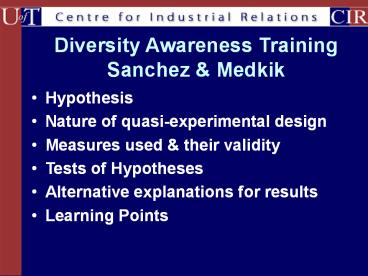Diversity Awareness Training Sanchez - PowerPoint PPT Presentation
Title:
Diversity Awareness Training Sanchez
Description:
Diversity Awareness Training Sanchez & Medkik Hypothesis Nature of quasi-experimental design Measures used & their validity Tests of Hypotheses Alternative ... – PowerPoint PPT presentation
Number of Views:175
Avg rating:3.0/5.0
Title: Diversity Awareness Training Sanchez
1
Diversity Awareness TrainingSanchez Medkik
- Hypothesis
- Nature of quasi-experimental design
- Measures used their validity
- Tests of Hypotheses
- Alternative explanations for results
- Learning Points
2
Hypothesis
Diversity Awareness Training
Cultural Awareness
Differential Treatment of Culturally Different
Individuals
3
Method
- Participants
- 125 supervisors/mgrs in a county government
- 125 Raters of supervisors/mg above
- Are no raters evaluating two supervisors?
Condition Number of Participants
Diversity Training 69
Control 56
4
Method
- Design
- No random assignment to conditions
- Participants in experimental group were chosen
bec.. - they were one of 4 employees with the longest
tenure in each of their departments - had not received diversity awareness training
- Participants in control group were matched on
tenure with those in the experimental group - Control group Ps would have been eligible for
training - Did Ps in control group receive training before?
5
Measures
- Pre-training performance ratings
- Relevant to training dimensions (e.g., Coworker
contact, communication skills) - Extracted for the year immediately before
training - 5-point rating scales ( of items not specified)
- Anchors used poor to excellent
- Issues
- Reliability not given
6
Method
- Matched control and experimental groups on
tenure - Control variables
- Pre-training performance rating
- Demographics
- Gender, ethnicity, tenure, educational level
- Demographics of coworkers who rated Ps in control
experimental groups - Gender ethnicity
7
Establishing equivalence
- Tested for mean differences between experimental
and control group on - Matching and Control variables
- Do not present appropriate statistical test
results for means but present sds - Present means for categorical variables(!)
- Present correlational information
8
Means on Demographic Var
9
Means on Continuous Control Variables
Pre-training Performance Control Experimental
Coworker contact 4.14 4.10
Communication 4.17 4.12
Diversity training is not significantly
correlated with any of these variables
10
Training Outcome Measures
- Trainee reactions
- 6-items
- 5-point Likert rating scales
- Reliability.98
- Completed immediately after training
- Only completed by experimental group
- Usefulness of mean data
11
Training Outcome Measures
- Cultural Awareness
- Correctly pair nine-terms with their meanings
- Completed 1 year after training
- Previously developed scale called CAI
- Reliability.75
12
Training Outcome Measures
- Differential Treatment Ratings
- Coworkers ratings of how Ps treated those who
were culturally different from Ps - 1 year after training
- Previously developed discrimination scale
- 10 items rated on 5 point scale
- Reliability.98
13
Means on Outcome Variables
Variable Control Experimental
Cultural Awareness 5.66 6.24
Differential Treatment 1.26 1.44
Diversity training is not significantly
correlated with any of these variables
14
Validity of Rater Sample
- No differences between participant and rater
sample on - Proportions of men women
- Proportions of Whites VMs
- Correlation b/w post-training measures and
performance ratings, between supervisor and peer
performance ratings - Did raters know whether target was in the
experimental vs. control group? - Higher expectations
15
Preliminary Analyses
- Significant correlations between (control)
demographic variables - Tenure Educational level -.26
- Ethnicity and Educational Level -.26
- Gender Ethnicity -.39
- Coding issues?
- 1male, 0female
- 1White, 0VM
- 1less than 5 years, 521 years or more tenure
- Educational level coding not provided
16
Preliminary Analyses
- Significant correlations between pre-training
performance demographic variables - Coworker Contact Communication.50
- Coworker contact gender-.24
- Communication gender-.22
- Communication education.25
- Coding 1male, 0female
17
Validity of Outcome Variable
- Trainee reactions not related to any variable
- Usefulness of trainee reactions
- Statistical Power issues
18
Validity of Outcome Variable
- Significant correlations with b/w Cultural
awareness control variable - Coworker contact performance .27
- Criterion validity of outcome variable
- Ethnicity.30 1White, 0VM
- Education level.50
19
Validity of Outcome Variable
- Significant correlations between Differential
treatment control variables - Gender.20 (1male, 0female)
- Rater ethnicity.30 (1White, 0VM OR 1VM
0White) - But no correlation b/w DT pre-training
performance rating - Implications for
- Using type of raters
- Criterion validity of differential treatment
ratings - Do supervisors have opportunity to notice
differential treatment?
20
Hypothesis Testing
- Regression analyses to test for mediation effects
requires - Independent and dependent variable to be related
- Mediator variable to be related to both
independent dependent variables - Criteria not met for
- IVTraining
- MediatorCultural Awareness
- DVDifferential treatment
- BUT.forging ahead!
21
Hypothesis Testing of fake data?
Step Predictor R2 ?R2 ß
1 Participant Ethnicity 13 13 -17
Rater Ethnicity 25
2 Training 19 06 25
3 Training 19 0 25
Cultural Awareness 12
3e Rater Ethnicity x Training 26 07 44
22
Graph of Interaction
23
Discussion
- Lack of support for hypotheses
- Diversity training did not have any effect on
social perception biases - Educational level participant ethnicity
predicted cultural awareness - Trainee reactions were positive(!)
- Uselessness of these types of measures
24
Alternative Explanations
- Diffusion of treatment among controls
- Not supported by higher differential treatment
ratings given to trained participants - Selection bias
- Lack of differences on control variables
including pre-training performance ratings - Trainees held to higher standard by non-white
raters
25
Alternative Explanations
- Qualitative analyses of interviews with non-white
raters of trainees - Possible backlash due to
- Lack of information re purpose of training
- Timing of post-test need for post-training
support - Pre-training beliefs feelings
- Usefulness of non-white raters who interact
w/diversity trainee
26
Learning Points from Article
- Writing up unexpected results
- Presentation of statistical results
- Means vs. frequencies depends on type of variable
- Double check statistical results
- Discrepancy between correlational and regression
tables - Analyses should also be guided by hypotheses































